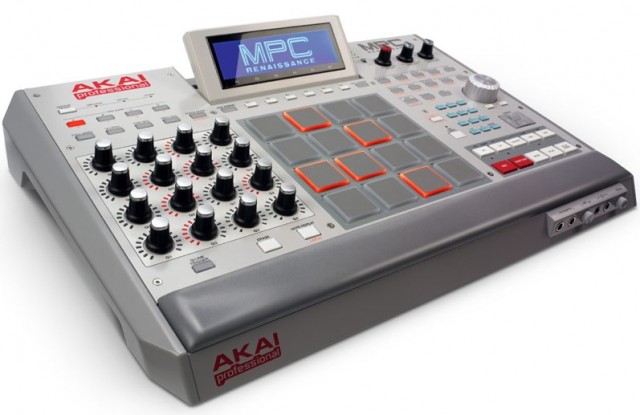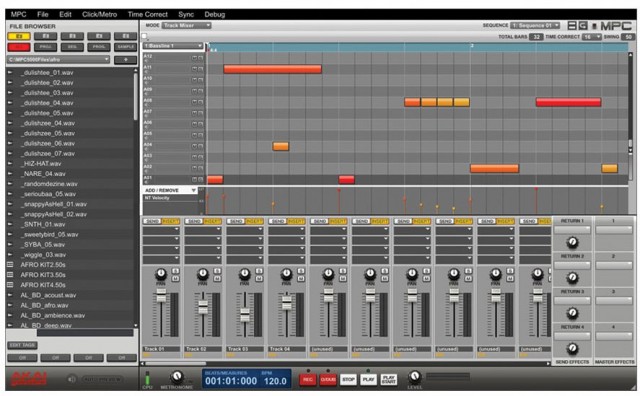The MPC name and MPC legend are as big as ever. But the current products? Not so much. Let’s face it: Akai could use a bit of a renaissance. Users these days put just as much stock in the MPC as a concept, and the MPC hardware still attracts users, but other products are stealing Akai’s thunder (Ableton Live, Native Instruments Maschine), and the human faces beloved by users aren’t at Akai (from the hacked JJOS firmware to Roger Linn off working on the Dave Smith-released Tempest). And while it doesn’t have the same mass appeal, hardware from other makers – the Tempest or the Machinedrum and Octatrack – have more street cred these days. That isn’t to say Akai isn’t doing well, but ironically, most of the Akai users I run into these days are using the APC with Ableton, or a treasured MPC from some years back.
This week, we get a glimpse of Akai’s strategy for changing that. The surprise: all three products are controllers for software, not the all-in-one, integrated hardware that made the MPC famous.
To many, it may be more the sad end of an era than the beginning of a new one. With plenty of software tools on the market, Akai was in the eyes of a loyal user base the go-to name for integrated hardware. But we’ll see if the MPC can win over those same folks with greater flexibility, as an apparent concession to the reduced development cost and expanded capabilities of relying on a computer for horsepower.
The MPC Renaissance is a larger controller with integrated audio and MIDI interface. It has a “Vintage Mode” said to emulate the sound “character” of the MPC3000, MPC60, and other units. And it comes with a fold-up LED screen and backlit pads. But the actual sound generation relies on the computer; it’s an interactive controller. We’ve, of course, seen this notion before, in Native Instruments’ Maschine. Whether that direct comparison is ultimately fair or not, the popularity of Maschine and the fact that it came first will make such comparisons inevitable. The major difference in Akai’s approach is that this is a big controller, complete with vintage-style palm rests and loads of I/O. It’s a Cadillac Escalade to NI’s Volkswagen Jetta. And with that extra space, you get more controls, like a stunning 4×4 array of encoders with LEDs, as popularized on Akai’s APC.
And the hardware looks far more elaborate than what we’ve tended to see, even from Akai. It’s the first controller that seems like it’d look at home next to an original MPC.
I like that the controller won’t be mistaken for anything but an MPC. The big question is, is Akai any good at making software? The first screenshot isn’t exactly pulse-quickening, though it does have plug-in support out of the gate. I wouldn’t judge on a preview, but I’ll say this: I think the software will make or break this product, and that’s what I’ll be asking about when I visit Akai at NAMM in Anaheim.
The other two products are teased now and coming soon:
MPC Studio is a “slimline” controller. (Well, almost anything would be more slimline than the massive, wide-load Renaissance, so we’ll see what that means.)
MPC Fly is a controller for iPad 2. If you can get over the name and the latest leap on the iPad bandwagon, consider this – there’s some seriously major consumer appeal here, and of the three, the Fly is the one where Akai is first to market. That makes a big difference. I can see why they kept it for last, even if it may be the least appealing to MPC loyalists.
I’ll reserve judgment on any of this, as I have no idea who worked on these products at Akai, or what the quality will be. My concern is that the appeal of the MPC is really integrated hardware, and mixing the computer into the equation is something other products already do reasonably well – ironically, including Akai’s own APC coupled with Ableton. It seems a huge test for Akai going into this generation of music production.
Now, I’m willing to accept the possibility that this will be a flexible, functional approach. But first, I’ll just wait through what I imagine will be a hailstorm of angry MPC purists. After that settles down, we’ll finally see if Akai is, as they’re putting it, “changing the game” – or if they’re in the same league. What determines that may be just how much the game has changed already. (And from the Ableton side, it’ll be a big test of the partnership with Akai for integrating hardware and software.)
Video below, with some artists onboard already – AraabMUZIK, Sean C, and LV.
Product specs and full info will be available week after next, coinciding with the massive NAMM trade show in California. We’ll be there with Akai.
Early spec highlights – basically, think MPC-style sound samples and features, and lots of audio I/O, as the two things missing from most rivals:
MPC Note Repeat, MPC Swing and MPC transport controls
MPC software for Mac or PC with 64-track sequencing capability
Two XLR-1/4” combo inputs and dedicated turntable input
Four-channel USB 2.0 audio interface and two-port US B 2.0 hub built in
Up to eight pad banks
Two MIDI inputs and four MIDI outputs
Stereo 1/4” out, stereo assignable mix 1/4” out & S/PDIF I/O
MPC SOFTWARE
64-track sequencing capability
6GB+ sound library, including all of the sounds of the classic MPC3000
Instant mapping and real-time adjustment of VST plug-ins
Record each track as an MPC drum program, Keygroup program or VST plug-in
Runs standalone and as VST, AU or RTAS plug-in
Supports WAV, MP3, AIFF, REX and SND
Supports samples and sequences from any MPC ever made
Mac and PC-compatible
http://www.akaiprompc.com/
http://www.akaiprompc.com/mpcrenaissance.php

